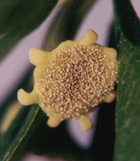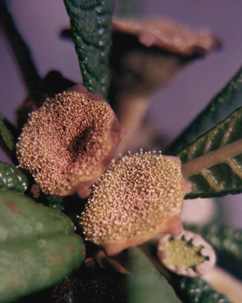
|
An inflorescense on the UCLA clone just beginning the transition between receptive stigmas to stamen maturation. This would be the last chance to pollinate with another clone using a small camel's hair brush. |
|
|
I have known this plant since I was a student at UCLA in the 1960's. It was introduced to me by David Verity, who curated the succulent collection at the UCLA Botanical Garden (now The Mildred E. Mathias Memorial Botanical Garden). A small plant had been obtained from the Universitry of California, Berkeley Botanical Gardens. It was characterized by having relatively broad leaves that were deeply grooved by veins. The trunk was a smooth very light yellowish white. As the plant got larger, the trunk thickened considerably. Branches also were thick. Cuttings were taken as soon as the plant was large enough. These were rooted in the greenhouse with difficulty, but I managed to get one to root before I graduated and left the university. This plant was brought to CSUF when I was hired in 1971.
During the following years, the plant was moved up to larger pots. The potting mix was a fast draining mix high in decomposed granite gravel at first, then pumice was substituted. Cuttings were also taken to start back-up plants as well as material for distribution/trade. One cutting was planted in a ground bed in pure pumice. This plant grew rapidly and soon surpassed the mother plant in size.
Flowers appeared within, if I recollect correctly, five to seven years after I started at CSUF. All attempts to produce seed failed. The rumor mill reported that this particular clone was "male" and that a female plant would have to be found. Being a believer in "comparison taxonomy" I knew that another clone would have to be obtained and grown to flowering so that the floral anatomy could be visually compared.
The greenhouse curators/technicians have a close network, especially here in California. I have exchanged materials with most of the California State Universities (CSU) and University of California (UC) campi that have a working teaching collection. This serves at least a two-fold purpose: to increase each other's collections' diversity and to provide back up in case of plant loss. As it turned out, the Plant Science greenhouse at the UC Davis had a different clone. Tim Metcalf kindly provided a rooted cutting of their clone (UCD clone). I provided him with a rooted cutting of the "UCLA clone." Now it was only a matter of time.
During this time, a third clone was obtained from Wayne Mrazyk. It bore a strong resemblance to the UCLA clone. As material had been passed around for years, there was no way then of knowing whether this was the same as the UCLA clone. Again, time would tell.
In the late 1970's to early 1980, the UCLA clone began to produce flowers. The plants were generally kept very dry during the winter as this is when they generally went dormant, shedding all leaves. The flowers, or more correctly, the inflorescenses, which are like open faced figs, appeared in the winter. First visible as knobby buds, the center was exposed as the outer edges spread apart.
Pollination was attempted using inflorescenses the same age, older crossed with younger, and even ones without visible stamens. Still, no seeds- the heads gradually filled out, turned brown and fell off. Upon dissection, it appeared that there were ovaries, but without a different clone, I could not determine whether we were dealing with self-sterility or a dioecious plant ( male or staminate) with non-functional ovaries.
By the early 1980's, the UC Davis clone began to produce flowers. The aspect of this clone is different, in that the leaves are narrower and the inflorescenses are smaller with a central dip. The "rays" are also a different shape. See figures below.
Reciprocal pollinations were made between the UCLA and UCD clones in 1989 when they finally flowered almost together. There was less than two weeks or so of overlap, espcially to try pollinating very young inflorescenses. However, within a month, it was evident that seeds were being formed as the inflorescenses were swelling in spots. The large UCLA plant in the ground bed was also producing a few seeds. Then disaster! The UCLA mother plant along with almost ripe seeds was stolen!
An inflorescense on the UCLA clone just beginning the
transition between receptive stigmas to stamen maturation.
This would be the last chance to pollinate with another
clone using a small camel's hair brush.

Full stamen maturation. Stamens continue to mature
over a period of time. A newer and female receptive
inflorescence can be seen just out of focus to the lower
right. This is the UC Davis clone which is characterized by
a more funnelform recepticle.

All stamens have now finished shedding pollen.

|
|
The bulges are where seeds were ejected. Seeds are ejected several feet and plants have appeared on the bench across the aisle, at least a meter (3 feet+) away! Seeds also may land on the floor where they may get washed under the bench and into to gravel. One plant has volunteered on the opposite side of the greenhouse under the bench. From rarity to "weed..." Such is horticulture. |
This page is still under construction.
14 July 1999